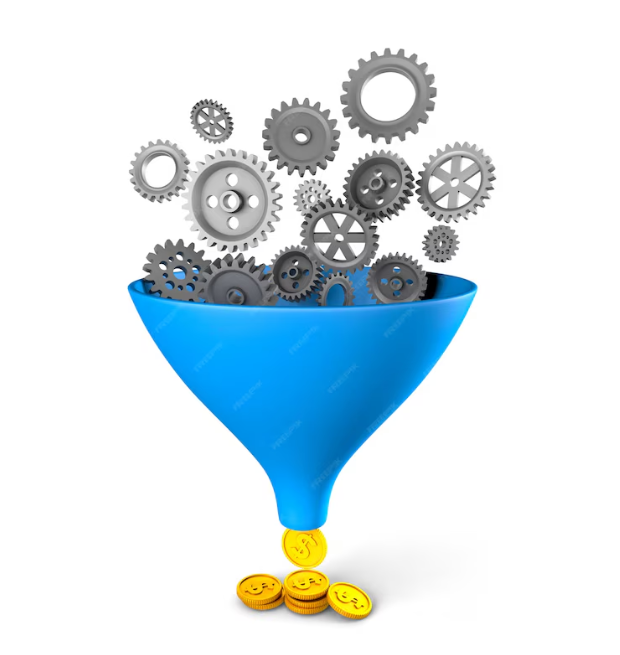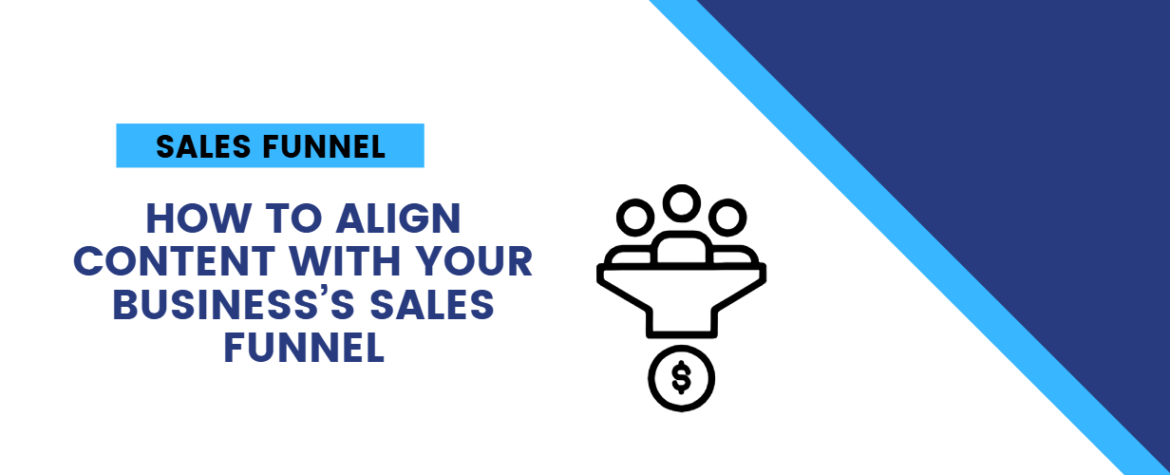Creating content that speaks directly to your audience is crucial, but it’s just as important to understand where they are in their buying journey. This is where the concept of the sales funnel comes in. The sales funnel represents the steps potential customers go through before making a purchase, and aligning your content with each stage of this funnel can significantly improve your chances of converting leads into loyal customers.
In this blog, we will explore how to align content with your business’s sales funnel to ensure that each piece of content helps guide prospects smoothly from awareness to decision-making, driving better engagement and, ultimately, conversions.
Understanding the Sales Funnel
Before we dive into content creation strategies, it’s important to understand the typical sales funnel stages:

- Awareness Stage – This is when potential customers realize they have a problem or need. They may not yet know who can solve it or how to solve it.
- Consideration Stage – Now that they know they have a problem, they begin researching solutions. They explore different options, compare providers, and learn more about available solutions.
- Decision Stage – At this stage, prospects are ready to make a decision. They know what they need, and they are evaluating the specific products or services that can fulfill that need. This is the point where they will choose the company they will purchase from.
By understanding these stages, you can tailor your content to guide prospects through their journey. Let’s explore how to align content with each stage of the funnel.
1. Awareness Stage: Capturing Attention with Valuable Content
In the awareness stage, your potential customers may not yet know about your brand or the solution you offer. They are looking for information on a problem or pain point they are experiencing. Therefore, the content you create needs to focus on educating and informing them about their challenges, not on selling your product right away.
Best Practice: Focus on providing educational content that speaks to the prospect’s problem or need. This is the time to create content that raises awareness about the issue at hand and introduces your brand in a non-salesy way.
Types of Content for the Awareness Stage:
- Blog Posts: Write informational blog articles that discuss common problems or challenges your target audience faces. For example, if you sell project management software, you could create content like “Common Challenges in Project Management” or “Why Projects Fail: Common Pitfalls and How to Avoid Them.”
- Infographics: Create easy-to-digest visual content that explains complex problems or statistics related to your audience’s pain points.
- Social Media Posts: Share educational tips, stats, and industry news to engage your audience and create awareness around relevant topics.
- Podcasts/Webinars: Host or share interviews with industry experts, discussing common problems and offering general solutions.
Example: A company selling cybersecurity software can create blog posts that answer common questions like “What Is Cybersecurity?" or “Why Small Businesses Need Cybersecurity,” providing helpful insights without directly promoting the product yet.
Statistical Insight: Research by Demand Gen Report shows that 47% of buyers consume 3-5 pieces of content before they engage with a sales rep. Providing helpful content at this stage builds brand trust and helps prospects move toward the next phase of their journey.
2. Consideration Stage: Nurturing Leads with Solution-Oriented Content
Once a prospect has recognized their problem, they move into the consideration stage. They now understand what they need to solve their issue, and they begin searching for available solutions. At this point, you want your content to show them that your business can help solve their problem.

Your content in this stage should be more focused on explaining how your product or service provides value and addresses their pain points, without being too aggressive in the sales pitch.
Best Practice: Create solution-focused content that positions your product or service as a viable solution to the problems they’re facing. Think of it as showing how your offering can make their lives easier or better.
Types of Content for the Consideration Stage:
- Case Studies: Share stories of how other customers or companies similar to your prospect have solved similar problems using your solution. This provides social proof and helps build trust.
- Ebooks/Whitepapers: Offer in-depth guides or downloadable content that dives deeper into the problems and solutions. For example, “The Ultimate Guide to Choosing the Right CRM for Your Business.”
- Product Demos/Explainer Videos: Create videos that explain how your product works or show its benefits in action.
- Comparison Articles: Write content that compares your solution to others in the market. Make sure to highlight the unique value your solution provides without being overly promotional.
Example: A SaaS company offering a project management tool could create a detailed whitepaper titled “How to Streamline Your Team’s Workflow with Project Management Software” or host a product demo that shows exactly how their tool solves common pain points.
Statistical Insight: According to HubSpot, 70% of B2B buyers prefer to consume content that’s designed for their specific industry. During the consideration stage, providing tailored content helps your leads evaluate your offering more effectively.
3. Decision Stage: Encouraging Conversion with Persuasive Content
In the decision stage, your potential customers are ready to make a choice. They have explored multiple solutions, and now they are comparing specific products or services to finalize their decision. At this point, they need to feel confident that your product or service is the best fit for their needs.

This is where you want to focus on persuasive, conversion-oriented content that emphasizes the value and benefits of your offering.
Best Practice: Create content that reinforces your product’s value and highlights why it’s the best option for solving the prospect’s problem. At this point, your content should help prospects feel confident in their decision to choose your business over competitors.
Types of Content for the Decision Stage:
- Product Comparisons: Create detailed comparisons between your product and your competitors, focusing on the unique benefits your product offers.
- Customer Testimonials and Reviews: Showcase positive feedback from existing customers that specifically highlight how your product has solved their problems.
- ROI Calculators: Offer tools that help prospects calculate the potential return on investment (ROI) of using your product or service.
- Free Trials or Demos: Offer a trial or demo of your product so prospects can experience the value for themselves.
- Pricing Pages: Be transparent with your pricing information, offering clear and easy-to-understand options.
Example: A business offering cloud storage solutions can create a pricing page and offer a free trial. They could also share customer testimonials that focus on how easy it is to integrate their solution into daily operations.
Statistical Insight: According to Salesforce, 79% of leads who are not yet ready to buy will continue to engage with companies that provide useful content, especially when they get a chance to try before they buy.
4. Post-Purchase Stage: Retaining Customers with Ongoing Content
The sales funnel doesn’t end after a purchase is made. Customer retention is equally important, and content can play a vital role in ensuring that your customers stay loyal and engaged with your brand. After the purchase, your content should focus on helping customers get the most out of your product and building long-term relationships.

Best Practice: Create content that nurtures and supports your customers after they make a purchase, helping them maximize the value they get from your product.
Types of Content for the Post-Purchase Stage:
- Onboarding Guides: Provide clear and helpful guides, videos, or tutorials to help new customers get started with your product.
- Customer Support Content: Create FAQs, knowledge bases, and troubleshooting guides that help customers resolve issues.
- Up-sell and Cross-sell Content: Suggest additional products, services, or features that can enhance your customers’ experience and increase their satisfaction with your brand.
- Customer Satisfaction Surveys: Engage with customers to gather feedback on their experience and identify areas for improvement.
Example: A company selling an online course might provide an onboarding guide to help customers navigate the course platform, offer tips and tricks on how to get the most out of the course, and send follow-up emails suggesting other courses or resources.
Statistical Insight: Research by Gartner reveals that loyal customers are 50% more likely to try new products from a brand they already trust and are 3 times more likely to refer others to the company.
Conclusion
Aligning content with your business’s sales funnel is key to guiding potential customers through their journey from awareness to decision, and ultimately, turning them into loyal, long-term customers. By understanding where your audience is in their buying journey and tailoring your content to meet their needs at each stage, you can build stronger relationships, increase conversions, and foster customer loyalty.
Remember, each stage of the sales funnel requires different content types and strategies—awareness-focused content, solution-oriented content, persuasive content, and post-purchase support content. By using these content strategies effectively, you will help prospects make informed decisions, boost conversions, and ultimately drive business growth.


